|
Diaphones were a once familiar sound heard
throughout the Great Lakes from the early 1920s until the late 1960s /
early 1970s when most lighthouses were automated. 120 such installations
existed on both U.S. and Canadian waterways in the 1950s. The two most
commonly heard Diaphones were the "Standard" Diaphone, which
gave a full steady upper tone that terminated in a heavy
"grunt" tone, and the classic two-tone Diaphone that produced
an upper tone followed by a full steady low tone of equal or greater
duration than the upper tone.
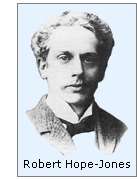 In 1895, Robert Hope-Jones, an English
pipe organ designer and builder, developed a special tone generator for
his famous WURLITZER organ; the WURLITZER was a popular musical
instrument in the days of silent movies and live stage performances. The
new tone generator consisted of a casing that contained a slotted
cylinder with a similarly slotted piston. Air was channeled through the
casing in such a way that it caused the piston to reciprocate within the
cylinder. The major portion of the air was discharged through the slots
in both the piston and cylinder as the piston stroked back and forth in
the cylinder. As the air passed through slots in the piston, it was
"chopped" which caused a vibration that was amplified though a
long cone shaped trumpet. Hope-Jones labeled this new tone
"diaphonic" (meaning two or more tones"). The new tone
had a full, powerful harmonic structure that could be heard over some of
the other tones on the pipe organ. He called his new tone generator a
Diaphone. In 1895, Robert Hope-Jones, an English
pipe organ designer and builder, developed a special tone generator for
his famous WURLITZER organ; the WURLITZER was a popular musical
instrument in the days of silent movies and live stage performances. The
new tone generator consisted of a casing that contained a slotted
cylinder with a similarly slotted piston. Air was channeled through the
casing in such a way that it caused the piston to reciprocate within the
cylinder. The major portion of the air was discharged through the slots
in both the piston and cylinder as the piston stroked back and forth in
the cylinder. As the air passed through slots in the piston, it was
"chopped" which caused a vibration that was amplified though a
long cone shaped trumpet. Hope-Jones labeled this new tone
"diaphonic" (meaning two or more tones"). The new tone
had a full, powerful harmonic structure that could be heard over some of
the other tones on the pipe organ. He called his new tone generator a
Diaphone.
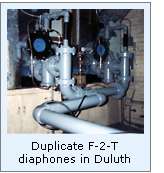 Around 1900, John Pell Northey, a
machinist / inventor who owned a factory that made valves and pipe
fittings, met with Robert Hope-Jones soon after Hope-Jones moved to the
United States. John Pell Northey took an interest in Hope-Jones's
invention and after some negotiating, obtained the rights to patent the
Diaphone. Northey immediately redesigned the Diaphone so that a
secondary air supply could be directed to the cylinder, which would give
the piston a more vigorous and uniform means of reciprocating within the
cylinder. Northey called this modification to the casing the
"motor" section (or chamber). By increasing the overall size
of the instrument and adding his motor air chamber, John Pell Northey
had developed an extremely powerful, harmonically rich sound signal that
would soon become the greatest foghorn ever produced. In 1903, Northey
patented his improvements to Robert Hope-Jones's invention and formed
his DIAPHONE SIGNAL Co. COY LTD. (also known the CANADIAN SIGNAL Co.) at
Toronto, Ontario, Canada. The first Diaphone employed as a foghorn in
the U.S. was at Buffalo, N.Y. in 1914. Diaphones ranged in size and
function from the tiny single tone Type "A" to the
"Standard" units (Types "C-C" through the huge Type
"L") which produced a high tone that terminated in a heavy
descending "grunt" tone, to the classic two-tone Type
"F-2-T" foghorn. Around 1900, John Pell Northey, a
machinist / inventor who owned a factory that made valves and pipe
fittings, met with Robert Hope-Jones soon after Hope-Jones moved to the
United States. John Pell Northey took an interest in Hope-Jones's
invention and after some negotiating, obtained the rights to patent the
Diaphone. Northey immediately redesigned the Diaphone so that a
secondary air supply could be directed to the cylinder, which would give
the piston a more vigorous and uniform means of reciprocating within the
cylinder. Northey called this modification to the casing the
"motor" section (or chamber). By increasing the overall size
of the instrument and adding his motor air chamber, John Pell Northey
had developed an extremely powerful, harmonically rich sound signal that
would soon become the greatest foghorn ever produced. In 1903, Northey
patented his improvements to Robert Hope-Jones's invention and formed
his DIAPHONE SIGNAL Co. COY LTD. (also known the CANADIAN SIGNAL Co.) at
Toronto, Ontario, Canada. The first Diaphone employed as a foghorn in
the U.S. was at Buffalo, N.Y. in 1914. Diaphones ranged in size and
function from the tiny single tone Type "A" to the
"Standard" units (Types "C-C" through the huge Type
"L") which produced a high tone that terminated in a heavy
descending "grunt" tone, to the classic two-tone Type
"F-2-T" foghorn.
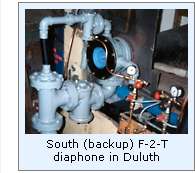 The Type "F" unit was the
most commonly employed Diaphone worldwide. The sound of the Type
"F" Diaphone is produced by low-pressure air (35 - 40 pounds
per square inch) being introduced to the piston and cylinder through the
motor and speaking chambers of the Diaphone's casing. The main air
supply to a typical Type "F" Diaphone is through 4" pipe
to the speaking chamber and 1- ½" pipe to the motor chamber. At
some point near the Diaphone, the 4" pipe is reduced down to 1-
½" pipe. The 1-½" air supply to the motor chamber is
controlled by a 1-½" air actuated operating valve called the motor
valve. The motor valve usually has a threaded input and a flanged
output. The motor valve also has a ¼" inlet at the bottom of the
valve body, and a ¼" outlet between the valve body and the output
flange. The ¼" inlet is from a timer that activates a pilot valve
(usually a solenoid of some type) which in turn activates the motor
valve. The Type "F" unit was the
most commonly employed Diaphone worldwide. The sound of the Type
"F" Diaphone is produced by low-pressure air (35 - 40 pounds
per square inch) being introduced to the piston and cylinder through the
motor and speaking chambers of the Diaphone's casing. The main air
supply to a typical Type "F" Diaphone is through 4" pipe
to the speaking chamber and 1- ½" pipe to the motor chamber. At
some point near the Diaphone, the 4" pipe is reduced down to 1-
½" pipe. The 1-½" air supply to the motor chamber is
controlled by a 1-½" air actuated operating valve called the motor
valve. The motor valve usually has a threaded input and a flanged
output. The motor valve also has a ¼" inlet at the bottom of the
valve body, and a ¼" outlet between the valve body and the output
flange. The ¼" inlet is from a timer that activates a pilot valve
(usually a solenoid of some type) which in turn activates the motor
valve.
"Speaking" air is the air
supply that actually flows through the slots in the piston and cylinder
and creates the tones of the Diaphone. The Speaking valve is configured
similarly to the motor valve but it is much larger (4") and has no
¼" outlet near its output flange.
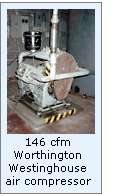 The operation of the
"Standard" Diaphone is as follows: Until the timer (or code
machine) opens the pilot valve, the control air supply to both operating
(motor and speaking) valves, and the air supply to both the motor and
speaking functions is restrained behind each valve respectively. When
the timer activates the pilot valve, control air passes along the
control air tubing to the ¼" inlet in the bottom of the motor
valve. The control air lifts a piston in the lower chamber of the valve
body which in turn lifts a valve stem / valve disk assembly. As the
valve disk lifts from its seat, the full force of the motor air supply
is allowed to pass through the valve to the motor chamber of the
Diaphone. Some of the motor air is diverted through the ¼" outlet
at the output side of the motor valve. The diverted motor air travels
down a short length of tubing to the ¼" inlet in the bottom cover
of the speaking valve and lifts the piston / valve stem / valve disk
assembly in the speaking valve. As the speaking valve opens, the main
charge of speaking air flows into the speaking chamber of the Diaphone.
Almost instantly and, simultaneously, the motor air causes the piston to
reciprocate in the cylinder as speaking air is forced between the slots
in both the cylinder and piston. The operation of the
"Standard" Diaphone is as follows: Until the timer (or code
machine) opens the pilot valve, the control air supply to both operating
(motor and speaking) valves, and the air supply to both the motor and
speaking functions is restrained behind each valve respectively. When
the timer activates the pilot valve, control air passes along the
control air tubing to the ¼" inlet in the bottom of the motor
valve. The control air lifts a piston in the lower chamber of the valve
body which in turn lifts a valve stem / valve disk assembly. As the
valve disk lifts from its seat, the full force of the motor air supply
is allowed to pass through the valve to the motor chamber of the
Diaphone. Some of the motor air is diverted through the ¼" outlet
at the output side of the motor valve. The diverted motor air travels
down a short length of tubing to the ¼" inlet in the bottom cover
of the speaking valve and lifts the piston / valve stem / valve disk
assembly in the speaking valve. As the speaking valve opens, the main
charge of speaking air flows into the speaking chamber of the Diaphone.
Almost instantly and, simultaneously, the motor air causes the piston to
reciprocate in the cylinder as speaking air is forced between the slots
in both the cylinder and piston. 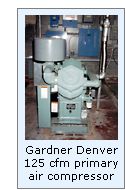 The combination of the action of the
motor air and speaking air creates a high tone of approximately 250Hz.
(Hertz, or cycles per second). When the Diaphone timer closes the pilot
valve, the flow of control air to the motor valve ceases and the motor
valve closes. The closing of the motor valve causes an interruption of
the flow of motor air to the motor air chamber as well as the flow of
control air to the speaking valve. There is some "lag" in the
closing of the operating valves. The motor valve closes first, which
causes the Diaphone piston to begin to slow down. Due to the lag between
the closing of the valves, a final puff of reduced pressure speaking air
is forced through the slots in the less rapidly reciprocating piston.
This action creates a tone of much lower frequency than the high tone
(somewhere between 93 - 150 Hz.). This brief low tone is referred to as
the "grunt" tone in "Standard" operation of the
Diaphone. Mariners could sometimes hear the grunt tone when the high
tone was "masked" by other sounds or the vessel was at a great
enough distance from the foghorn that the high tone would be inaudible
anyway (low frequency sounds carry farther, in air than high frequency
sounds).
The combination of the action of the
motor air and speaking air creates a high tone of approximately 250Hz.
(Hertz, or cycles per second). When the Diaphone timer closes the pilot
valve, the flow of control air to the motor valve ceases and the motor
valve closes. The closing of the motor valve causes an interruption of
the flow of motor air to the motor air chamber as well as the flow of
control air to the speaking valve. There is some "lag" in the
closing of the operating valves. The motor valve closes first, which
causes the Diaphone piston to begin to slow down. Due to the lag between
the closing of the valves, a final puff of reduced pressure speaking air
is forced through the slots in the less rapidly reciprocating piston.
This action creates a tone of much lower frequency than the high tone
(somewhere between 93 - 150 Hz.). This brief low tone is referred to as
the "grunt" tone in "Standard" operation of the
Diaphone. Mariners could sometimes hear the grunt tone when the high
tone was "masked" by other sounds or the vessel was at a great
enough distance from the foghorn that the high tone would be inaudible
anyway (low frequency sounds carry farther, in air than high frequency
sounds).
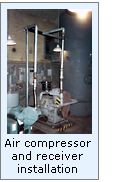 Around 1929, John Pell Northey's son
Rodney redesigned the Type "F" Diaphone so that the normal
grunt tone could be extended to produce a full steady sustained low tone
of equal or greater duration than the high tone. This modification to
the Type "F" Diaphone proved so effective that it was used to
replace the larger Type "G" and Type "K" units in
the U.S. (only 1 Type "K" Diaphone was ever employed in the
U.S. and that location was on the Farallon Islands off the coast of
California) and became the standard for all new major installations.
Rodney called his new revision the "Improved" Type
"F" Diaphone. In fact, some of the early issues of this unit
have simply TYPE "F" DIAPHONE nameplates. Around 1929, John Pell Northey's son
Rodney redesigned the Type "F" Diaphone so that the normal
grunt tone could be extended to produce a full steady sustained low tone
of equal or greater duration than the high tone. This modification to
the Type "F" Diaphone proved so effective that it was used to
replace the larger Type "G" and Type "K" units in
the U.S. (only 1 Type "K" Diaphone was ever employed in the
U.S. and that location was on the Farallon Islands off the coast of
California) and became the standard for all new major installations.
Rodney called his new revision the "Improved" Type
"F" Diaphone. In fact, some of the early issues of this unit
have simply TYPE "F" DIAPHONE nameplates.
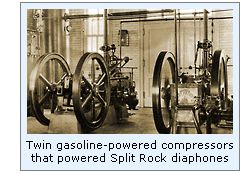 By 1932 Rodney Northey had inherited
the DIAPHONE SIGNAL Co. from his father. Due to the effects of the Great
Depression on the Canadian economy, Rodney was forced to sell the
company in order to stay financially "afloat" and marry his
fiancé. Most of the patent rights, foundry patterns, blueprints, and
machining tools were obtained by DECK BROTHERS - PRECISION MACHINISTS of
Buffalo, New York under contract by, and for, the U.S. Government (more
specifically the U.S. Lighthouse Service). After this transaction
occurred, the name of the Improved Type "F" Diaphone was
"Americanized" and changed to Type "F-2-T" Diaphone. By 1932 Rodney Northey had inherited
the DIAPHONE SIGNAL Co. from his father. Due to the effects of the Great
Depression on the Canadian economy, Rodney was forced to sell the
company in order to stay financially "afloat" and marry his
fiancé. Most of the patent rights, foundry patterns, blueprints, and
machining tools were obtained by DECK BROTHERS - PRECISION MACHINISTS of
Buffalo, New York under contract by, and for, the U.S. Government (more
specifically the U.S. Lighthouse Service). After this transaction
occurred, the name of the Improved Type "F" Diaphone was
"Americanized" and changed to Type "F-2-T" Diaphone.
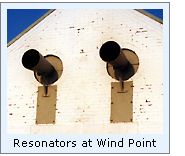 The "F" in "F-2-T"
means that the Diaphone is essentially a Type "F" Diaphone
[the diameter of the piston in both units is approx. 5" and both
units employ the same size of resonator (trumpet) and operating valves].
"2-T" means that the unit produces a true two-tone signal
where the low tone is a sustained tone instead of a "grunt".
"F-2-T" Diaphones were more commonly heard on the west coast
and frequently used on lightships on U.S. waterways. Recordings of these
two-tone foghorns can be heard in old cartoons, old radio and television
shows (i.e.; the door bell on the ADDAMS FAMILY), old movies, and even a
soap commercial that exclaimed that their product prevented
"BEEEE-ooooh". A nice feature of the "F-2-T"
Diaphone is that it can be configured to operate as a
"Standard" Type "F" Diaphone. The "F" in "F-2-T"
means that the Diaphone is essentially a Type "F" Diaphone
[the diameter of the piston in both units is approx. 5" and both
units employ the same size of resonator (trumpet) and operating valves].
"2-T" means that the unit produces a true two-tone signal
where the low tone is a sustained tone instead of a "grunt".
"F-2-T" Diaphones were more commonly heard on the west coast
and frequently used on lightships on U.S. waterways. Recordings of these
two-tone foghorns can be heard in old cartoons, old radio and television
shows (i.e.; the door bell on the ADDAMS FAMILY), old movies, and even a
soap commercial that exclaimed that their product prevented
"BEEEE-ooooh". A nice feature of the "F-2-T"
Diaphone is that it can be configured to operate as a
"Standard" Type "F" Diaphone.
|
 In 1895, Robert Hope-Jones, an English
pipe organ designer and builder, developed a special tone generator for
his famous WURLITZER organ; the WURLITZER was a popular musical
instrument in the days of silent movies and live stage performances. The
new tone generator consisted of a casing that contained a slotted
cylinder with a similarly slotted piston. Air was channeled through the
casing in such a way that it caused the piston to reciprocate within the
cylinder. The major portion of the air was discharged through the slots
in both the piston and cylinder as the piston stroked back and forth in
the cylinder. As the air passed through slots in the piston, it was
"chopped" which caused a vibration that was amplified though a
long cone shaped trumpet. Hope-Jones labeled this new tone
"diaphonic" (meaning two or more tones"). The new tone
had a full, powerful harmonic structure that could be heard over some of
the other tones on the pipe organ. He called his new tone generator a
Diaphone.
In 1895, Robert Hope-Jones, an English
pipe organ designer and builder, developed a special tone generator for
his famous WURLITZER organ; the WURLITZER was a popular musical
instrument in the days of silent movies and live stage performances. The
new tone generator consisted of a casing that contained a slotted
cylinder with a similarly slotted piston. Air was channeled through the
casing in such a way that it caused the piston to reciprocate within the
cylinder. The major portion of the air was discharged through the slots
in both the piston and cylinder as the piston stroked back and forth in
the cylinder. As the air passed through slots in the piston, it was
"chopped" which caused a vibration that was amplified though a
long cone shaped trumpet. Hope-Jones labeled this new tone
"diaphonic" (meaning two or more tones"). The new tone
had a full, powerful harmonic structure that could be heard over some of
the other tones on the pipe organ. He called his new tone generator a
Diaphone. Around 1900, John Pell Northey, a
machinist / inventor who owned a factory that made valves and pipe
fittings, met with Robert Hope-Jones soon after Hope-Jones moved to the
United States. John Pell Northey took an interest in Hope-Jones's
invention and after some negotiating, obtained the rights to patent the
Diaphone. Northey immediately redesigned the Diaphone so that a
secondary air supply could be directed to the cylinder, which would give
the piston a more vigorous and uniform means of reciprocating within the
cylinder. Northey called this modification to the casing the
"motor" section (or chamber). By increasing the overall size
of the instrument and adding his motor air chamber, John Pell Northey
had developed an extremely powerful, harmonically rich sound signal that
would soon become the greatest foghorn ever produced. In 1903, Northey
patented his improvements to Robert Hope-Jones's invention and formed
his DIAPHONE SIGNAL Co. COY LTD. (also known the CANADIAN SIGNAL Co.) at
Toronto, Ontario, Canada. The first Diaphone employed as a foghorn in
the U.S. was at Buffalo, N.Y. in 1914. Diaphones ranged in size and
function from the tiny single tone Type "A" to the
"Standard" units (Types "C-C" through the huge Type
"L") which produced a high tone that terminated in a heavy
descending "grunt" tone, to the classic two-tone Type
"F-2-T" foghorn.
Around 1900, John Pell Northey, a
machinist / inventor who owned a factory that made valves and pipe
fittings, met with Robert Hope-Jones soon after Hope-Jones moved to the
United States. John Pell Northey took an interest in Hope-Jones's
invention and after some negotiating, obtained the rights to patent the
Diaphone. Northey immediately redesigned the Diaphone so that a
secondary air supply could be directed to the cylinder, which would give
the piston a more vigorous and uniform means of reciprocating within the
cylinder. Northey called this modification to the casing the
"motor" section (or chamber). By increasing the overall size
of the instrument and adding his motor air chamber, John Pell Northey
had developed an extremely powerful, harmonically rich sound signal that
would soon become the greatest foghorn ever produced. In 1903, Northey
patented his improvements to Robert Hope-Jones's invention and formed
his DIAPHONE SIGNAL Co. COY LTD. (also known the CANADIAN SIGNAL Co.) at
Toronto, Ontario, Canada. The first Diaphone employed as a foghorn in
the U.S. was at Buffalo, N.Y. in 1914. Diaphones ranged in size and
function from the tiny single tone Type "A" to the
"Standard" units (Types "C-C" through the huge Type
"L") which produced a high tone that terminated in a heavy
descending "grunt" tone, to the classic two-tone Type
"F-2-T" foghorn. The Type "F" unit was the
most commonly employed Diaphone worldwide. The sound of the Type
"F" Diaphone is produced by low-pressure air (35 - 40 pounds
per square inch) being introduced to the piston and cylinder through the
motor and speaking chambers of the Diaphone's casing. The main air
supply to a typical Type "F" Diaphone is through 4" pipe
to the speaking chamber and 1- ½" pipe to the motor chamber. At
some point near the Diaphone, the 4" pipe is reduced down to 1-
½" pipe. The 1-½" air supply to the motor chamber is
controlled by a 1-½" air actuated operating valve called the motor
valve. The motor valve usually has a threaded input and a flanged
output. The motor valve also has a ¼" inlet at the bottom of the
valve body, and a ¼" outlet between the valve body and the output
flange. The ¼" inlet is from a timer that activates a pilot valve
(usually a solenoid of some type) which in turn activates the motor
valve.
The Type "F" unit was the
most commonly employed Diaphone worldwide. The sound of the Type
"F" Diaphone is produced by low-pressure air (35 - 40 pounds
per square inch) being introduced to the piston and cylinder through the
motor and speaking chambers of the Diaphone's casing. The main air
supply to a typical Type "F" Diaphone is through 4" pipe
to the speaking chamber and 1- ½" pipe to the motor chamber. At
some point near the Diaphone, the 4" pipe is reduced down to 1-
½" pipe. The 1-½" air supply to the motor chamber is
controlled by a 1-½" air actuated operating valve called the motor
valve. The motor valve usually has a threaded input and a flanged
output. The motor valve also has a ¼" inlet at the bottom of the
valve body, and a ¼" outlet between the valve body and the output
flange. The ¼" inlet is from a timer that activates a pilot valve
(usually a solenoid of some type) which in turn activates the motor
valve. The operation of the
"Standard" Diaphone is as follows: Until the timer (or code
machine) opens the pilot valve, the control air supply to both operating
(motor and speaking) valves, and the air supply to both the motor and
speaking functions is restrained behind each valve respectively. When
the timer activates the pilot valve, control air passes along the
control air tubing to the ¼" inlet in the bottom of the motor
valve. The control air lifts a piston in the lower chamber of the valve
body which in turn lifts a valve stem / valve disk assembly. As the
valve disk lifts from its seat, the full force of the motor air supply
is allowed to pass through the valve to the motor chamber of the
Diaphone. Some of the motor air is diverted through the ¼" outlet
at the output side of the motor valve. The diverted motor air travels
down a short length of tubing to the ¼" inlet in the bottom cover
of the speaking valve and lifts the piston / valve stem / valve disk
assembly in the speaking valve. As the speaking valve opens, the main
charge of speaking air flows into the speaking chamber of the Diaphone.
Almost instantly and, simultaneously, the motor air causes the piston to
reciprocate in the cylinder as speaking air is forced between the slots
in both the cylinder and piston.
The operation of the
"Standard" Diaphone is as follows: Until the timer (or code
machine) opens the pilot valve, the control air supply to both operating
(motor and speaking) valves, and the air supply to both the motor and
speaking functions is restrained behind each valve respectively. When
the timer activates the pilot valve, control air passes along the
control air tubing to the ¼" inlet in the bottom of the motor
valve. The control air lifts a piston in the lower chamber of the valve
body which in turn lifts a valve stem / valve disk assembly. As the
valve disk lifts from its seat, the full force of the motor air supply
is allowed to pass through the valve to the motor chamber of the
Diaphone. Some of the motor air is diverted through the ¼" outlet
at the output side of the motor valve. The diverted motor air travels
down a short length of tubing to the ¼" inlet in the bottom cover
of the speaking valve and lifts the piston / valve stem / valve disk
assembly in the speaking valve. As the speaking valve opens, the main
charge of speaking air flows into the speaking chamber of the Diaphone.
Almost instantly and, simultaneously, the motor air causes the piston to
reciprocate in the cylinder as speaking air is forced between the slots
in both the cylinder and piston.  The combination of the action of the
motor air and speaking air creates a high tone of approximately 250Hz.
(Hertz, or cycles per second). When the Diaphone timer closes the pilot
valve, the flow of control air to the motor valve ceases and the motor
valve closes. The closing of the motor valve causes an interruption of
the flow of motor air to the motor air chamber as well as the flow of
control air to the speaking valve. There is some "lag" in the
closing of the operating valves. The motor valve closes first, which
causes the Diaphone piston to begin to slow down. Due to the lag between
the closing of the valves, a final puff of reduced pressure speaking air
is forced through the slots in the less rapidly reciprocating piston.
This action creates a tone of much lower frequency than the high tone
(somewhere between 93 - 150 Hz.). This brief low tone is referred to as
the "grunt" tone in "Standard" operation of the
Diaphone. Mariners could sometimes hear the grunt tone when the high
tone was "masked" by other sounds or the vessel was at a great
enough distance from the foghorn that the high tone would be inaudible
anyway (low frequency sounds carry farther, in air than high frequency
sounds).
The combination of the action of the
motor air and speaking air creates a high tone of approximately 250Hz.
(Hertz, or cycles per second). When the Diaphone timer closes the pilot
valve, the flow of control air to the motor valve ceases and the motor
valve closes. The closing of the motor valve causes an interruption of
the flow of motor air to the motor air chamber as well as the flow of
control air to the speaking valve. There is some "lag" in the
closing of the operating valves. The motor valve closes first, which
causes the Diaphone piston to begin to slow down. Due to the lag between
the closing of the valves, a final puff of reduced pressure speaking air
is forced through the slots in the less rapidly reciprocating piston.
This action creates a tone of much lower frequency than the high tone
(somewhere between 93 - 150 Hz.). This brief low tone is referred to as
the "grunt" tone in "Standard" operation of the
Diaphone. Mariners could sometimes hear the grunt tone when the high
tone was "masked" by other sounds or the vessel was at a great
enough distance from the foghorn that the high tone would be inaudible
anyway (low frequency sounds carry farther, in air than high frequency
sounds). Around 1929, John Pell Northey's son
Rodney redesigned the Type "F" Diaphone so that the normal
grunt tone could be extended to produce a full steady sustained low tone
of equal or greater duration than the high tone. This modification to
the Type "F" Diaphone proved so effective that it was used to
replace the larger Type "G" and Type "K" units in
the U.S. (only 1 Type "K" Diaphone was ever employed in the
U.S. and that location was on the Farallon Islands off the coast of
California) and became the standard for all new major installations.
Rodney called his new revision the "Improved" Type
"F" Diaphone. In fact, some of the early issues of this unit
have simply TYPE "F" DIAPHONE nameplates.
Around 1929, John Pell Northey's son
Rodney redesigned the Type "F" Diaphone so that the normal
grunt tone could be extended to produce a full steady sustained low tone
of equal or greater duration than the high tone. This modification to
the Type "F" Diaphone proved so effective that it was used to
replace the larger Type "G" and Type "K" units in
the U.S. (only 1 Type "K" Diaphone was ever employed in the
U.S. and that location was on the Farallon Islands off the coast of
California) and became the standard for all new major installations.
Rodney called his new revision the "Improved" Type
"F" Diaphone. In fact, some of the early issues of this unit
have simply TYPE "F" DIAPHONE nameplates. By 1932 Rodney Northey had inherited
the DIAPHONE SIGNAL Co. from his father. Due to the effects of the Great
Depression on the Canadian economy, Rodney was forced to sell the
company in order to stay financially "afloat" and marry his
fiancé. Most of the patent rights, foundry patterns, blueprints, and
machining tools were obtained by DECK BROTHERS - PRECISION MACHINISTS of
Buffalo, New York under contract by, and for, the U.S. Government (more
specifically the U.S. Lighthouse Service). After this transaction
occurred, the name of the Improved Type "F" Diaphone was
"Americanized" and changed to Type "F-2-T" Diaphone.
By 1932 Rodney Northey had inherited
the DIAPHONE SIGNAL Co. from his father. Due to the effects of the Great
Depression on the Canadian economy, Rodney was forced to sell the
company in order to stay financially "afloat" and marry his
fiancé. Most of the patent rights, foundry patterns, blueprints, and
machining tools were obtained by DECK BROTHERS - PRECISION MACHINISTS of
Buffalo, New York under contract by, and for, the U.S. Government (more
specifically the U.S. Lighthouse Service). After this transaction
occurred, the name of the Improved Type "F" Diaphone was
"Americanized" and changed to Type "F-2-T" Diaphone. The "F" in "F-2-T"
means that the Diaphone is essentially a Type "F" Diaphone
[the diameter of the piston in both units is approx. 5" and both
units employ the same size of resonator (trumpet) and operating valves].
"2-T" means that the unit produces a true two-tone signal
where the low tone is a sustained tone instead of a "grunt".
"F-2-T" Diaphones were more commonly heard on the west coast
and frequently used on lightships on U.S. waterways. Recordings of these
two-tone foghorns can be heard in old cartoons, old radio and television
shows (i.e.; the door bell on the ADDAMS FAMILY), old movies, and even a
soap commercial that exclaimed that their product prevented
"BEEEE-ooooh". A nice feature of the "F-2-T"
Diaphone is that it can be configured to operate as a
"Standard" Type "F" Diaphone.
The "F" in "F-2-T"
means that the Diaphone is essentially a Type "F" Diaphone
[the diameter of the piston in both units is approx. 5" and both
units employ the same size of resonator (trumpet) and operating valves].
"2-T" means that the unit produces a true two-tone signal
where the low tone is a sustained tone instead of a "grunt".
"F-2-T" Diaphones were more commonly heard on the west coast
and frequently used on lightships on U.S. waterways. Recordings of these
two-tone foghorns can be heard in old cartoons, old radio and television
shows (i.e.; the door bell on the ADDAMS FAMILY), old movies, and even a
soap commercial that exclaimed that their product prevented
"BEEEE-ooooh". A nice feature of the "F-2-T"
Diaphone is that it can be configured to operate as a
"Standard" Type "F" Diaphone.